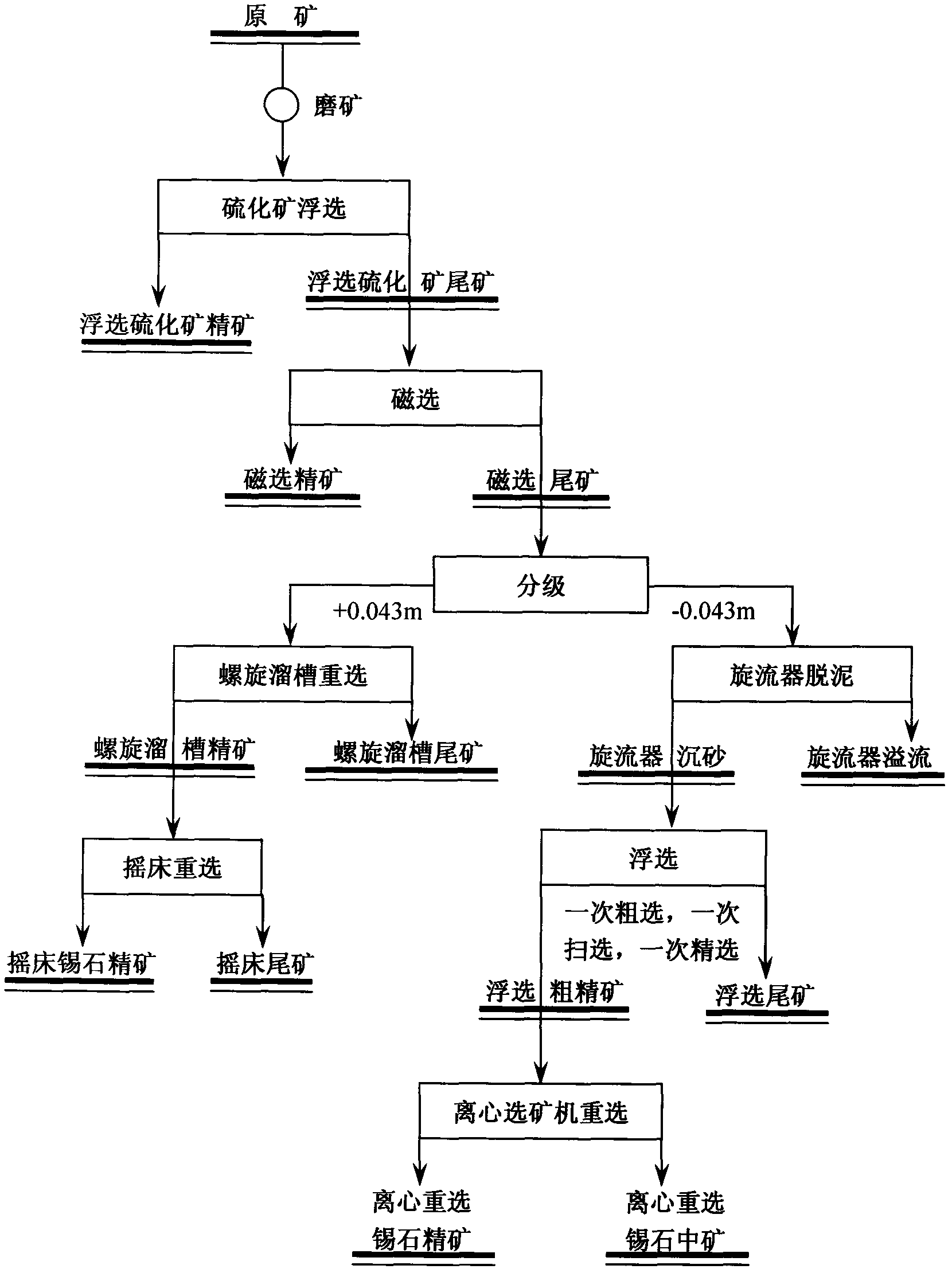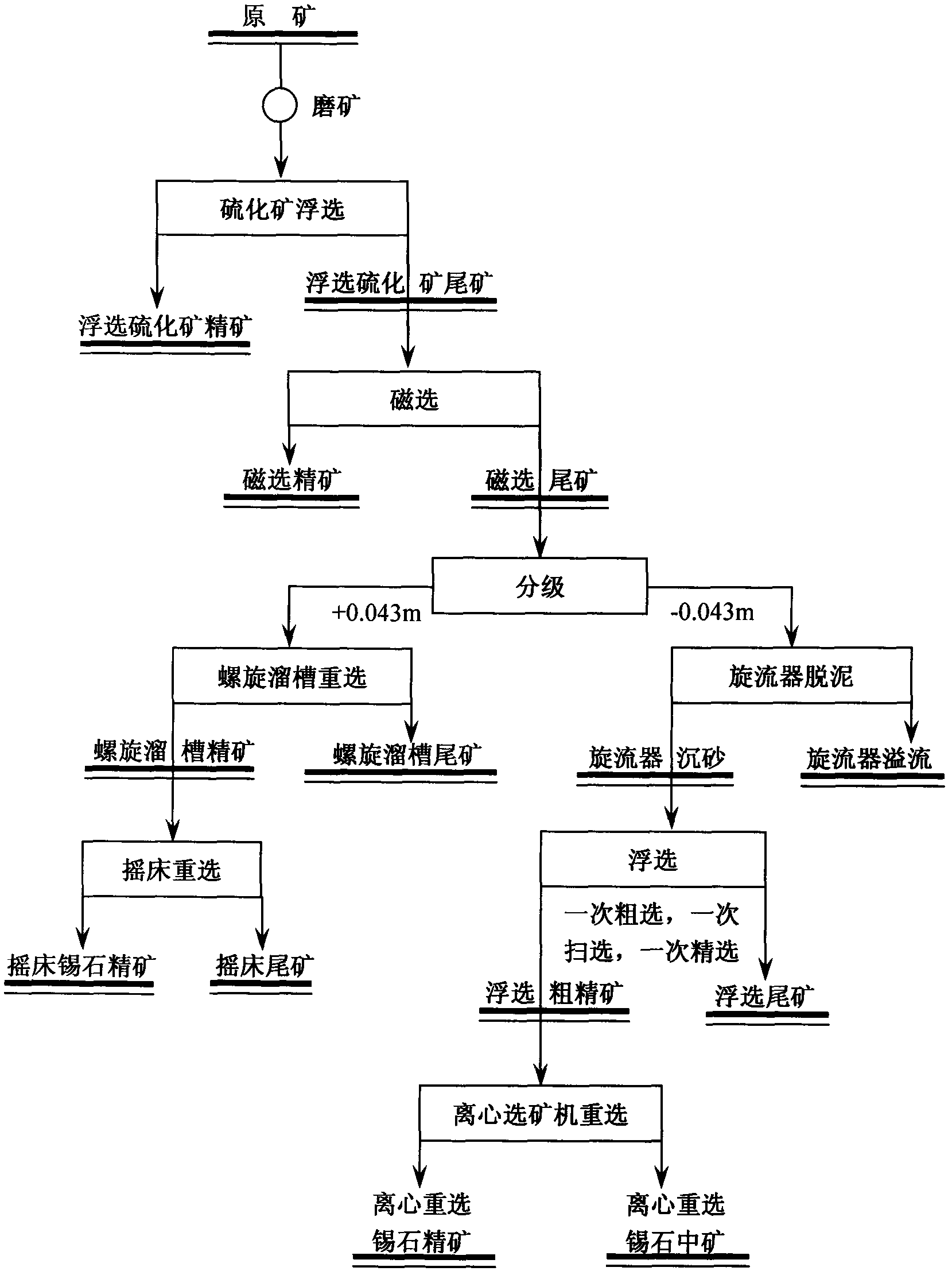Method for separating fine cassiterite
A beneficiation method and fine-grained technology are applied in the field of beneficiation of fine-grained cassiterite, which can solve the problems of low separation efficiency of fine-grained cassiterite, large consumption of flotation reagents, and high production cost, and achieves low cost and recovery of cassiterite. The effect of high rate and low consumption
- Summary
- Abstract
- Description
- Claims
- Application Information
AI Technical Summary
Problems solved by technology
Method used
Image
Examples
Embodiment 1
[0025] Cassiterite ore from a place in Yunnan, China is selected. The main mineral composition is cassiterite, pyrrhotite, sphalerite, magnetite, hornblende, biotite, quartz, pyroxene and calcite. The ore tin grade is 0.98%. Grind the raw ore to -0.074mm to account for 82%, add water to adjust the slurry to a concentration of 30%, and add 1000 grams of copper sulfate to adjust the slurry, 150 grams of butyl xanthate and 80 grams of foaming agent in sequence for each ton of raw ore No. 2 oil, carry out sulfide ore flotation to obtain flotation sulfide ore concentrate and flotation sulfide ore tailings, wherein the flotation sulfide ore concentrate contains 0.35% tin, and the tin recovery rate is 10.01%; flotation sulfide ore tailings Under the condition that the background magnetic field strength is 0.1T, magnetic separation is carried out to obtain magnetic separation concentrate and magnetic separation tailings, wherein the magnetic separation concentrate contains 0.25% tin, ...
Embodiment 2
[0027]The raw ore is the same as in Example 1, and the tin grade of the raw ore is 0.96%. Grind the raw ore to -0.074mm to account for 85%, add water to adjust the slurry to a concentration of 30%, and add 1500 grams of copper sulfate to adjust the slurry, 150 grams of butyl xanthate and 100 grams of foaming agent in sequence for each ton of raw ore No. 2 oil, carry out sulfide ore flotation to obtain flotation sulfide ore concentrate and flotation sulfide ore tailings, wherein the flotation sulfide ore concentrate contains 0.31% tin, and the tin recovery rate is 8.38%; flotation sulfide ore tailings Under the condition that the background magnetic field strength is 0.1T, magnetic separation is carried out to obtain magnetic separation concentrate and magnetic separation tailings, wherein the magnetic separation concentrate contains 0.22% tin, and the tin recovery rate is 2.06%; the classification of magnetic separation tailings is + Two particle sizes of 0.043mm and -0.043mm;...
Embodiment 3
[0029] The raw ore is the same as in Example 1, and the tin grade of the raw ore is 1.08%. Grind the raw ore to -0.074mm to account for 86%, add water to adjust the slurry to a concentration of 29%, and add 2000 grams of copper sulfate to adjust the slurry, 200 grams of butyl xanthate and 100 grams of foaming agent in sequence for each ton of raw ore No. 2 oil, carry out sulfide ore flotation to obtain flotation sulfide ore concentrate and flotation sulfide ore tailings, wherein the flotation sulfide ore concentrate contains 0.36% tin, and the tin recovery rate is 9.99%; flotation sulfide ore tailings Under the condition that the background magnetic field strength is 0.1T, magnetic separation is carried out to obtain magnetic separation concentrate and magnetic separation tailings, wherein the magnetic separation concentrate contains 0.30% tin, and the tin recovery rate is 2.22%; the magnetic separation tailings are graded as + Two particle sizes of 0.043mm and -0.043mm; +0.04...
PUM
 Login to View More
Login to View More Abstract
Description
Claims
Application Information
 Login to View More
Login to View More - R&D
- Intellectual Property
- Life Sciences
- Materials
- Tech Scout
- Unparalleled Data Quality
- Higher Quality Content
- 60% Fewer Hallucinations
Browse by: Latest US Patents, China's latest patents, Technical Efficacy Thesaurus, Application Domain, Technology Topic, Popular Technical Reports.
© 2025 PatSnap. All rights reserved.Legal|Privacy policy|Modern Slavery Act Transparency Statement|Sitemap|About US| Contact US: help@patsnap.com


